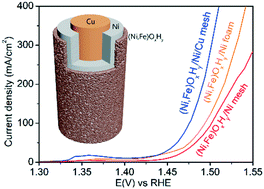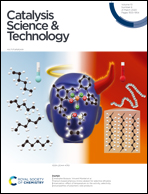A coaxial three-layer (Ni, Fe)OxHy/Ni/Cu mesh electrode: excellent oxygen evolution reaction activity for water electrolysis†
Abstract
Electrochemical water splitting is restrained by the sluggish oxygen evolution reaction (OER) due to the four-proton-coupled electron transfer. One key strategy for efficient large-scale production of hydrogen by water splitting is to design an electrode structure with low OER overpotential. Herein, a coaxial three-layer structure for the OER electrode is constructed by electroplating Ni on Cu mesh and then loading (Ni,Fe)OxHy catalyst via a modified solvothermal method. The obtained coaxial three-layer (Ni,Fe)OxHy/Ni/Cu mesh electrode exhibits an excellent OER performance with the overpotentials of 199 and 250 mV at 10 and 50 mA cm−2 and stability for over 72 h in 1 M KOH. The plated Ni layer is critical for the coaxial three-layer (Ni,Fe)OxHy/Ni/Cu mesh structure since it improves its stability by preventing Cu from corroding and meanwhile enhances the adhesive strength of (Ni,Fe)OxHy to the substrate because of its poor crystallinity, which facilitates charge transfer and leads to the extremely low overpotentials. Compared with Ni foam and Ni mesh, Cu mesh is more suitable for high production rate and large-area water splitting at large overpotentials because of its excellent conductivity and lower series electric resistance (Rs). Together with the extremely low cost of Cu mesh, the present coaxial three-layer (Ni,Fe)OxHy/Ni/Cu mesh electrode is promising for future industrial application.



 Please wait while we load your content...
Please wait while we load your content...